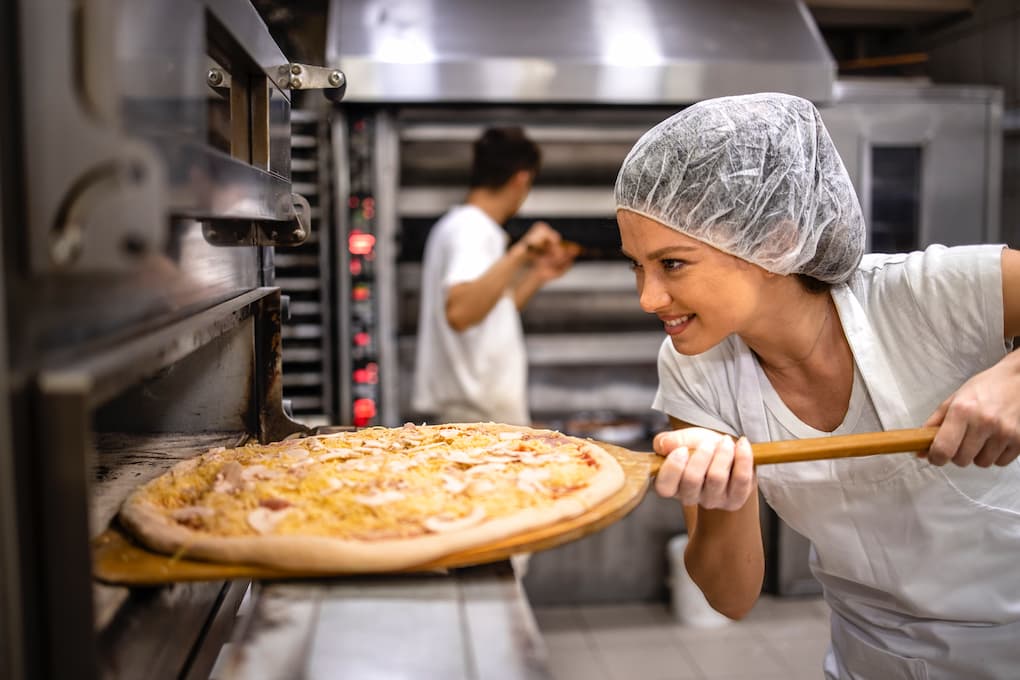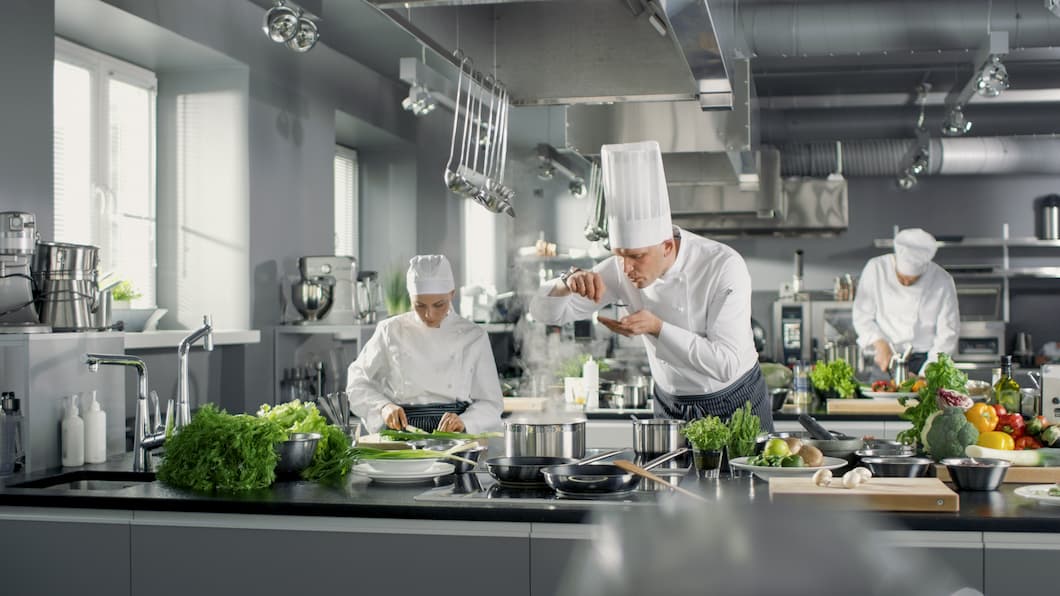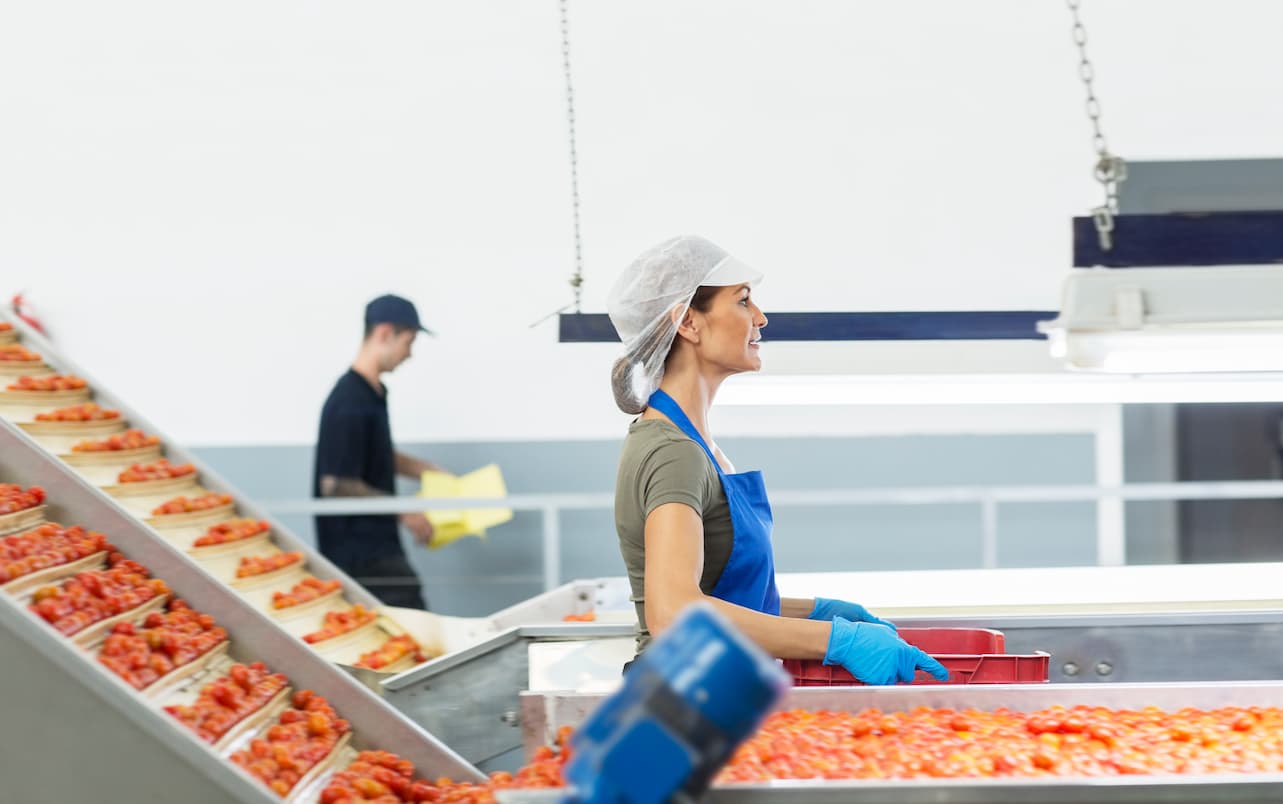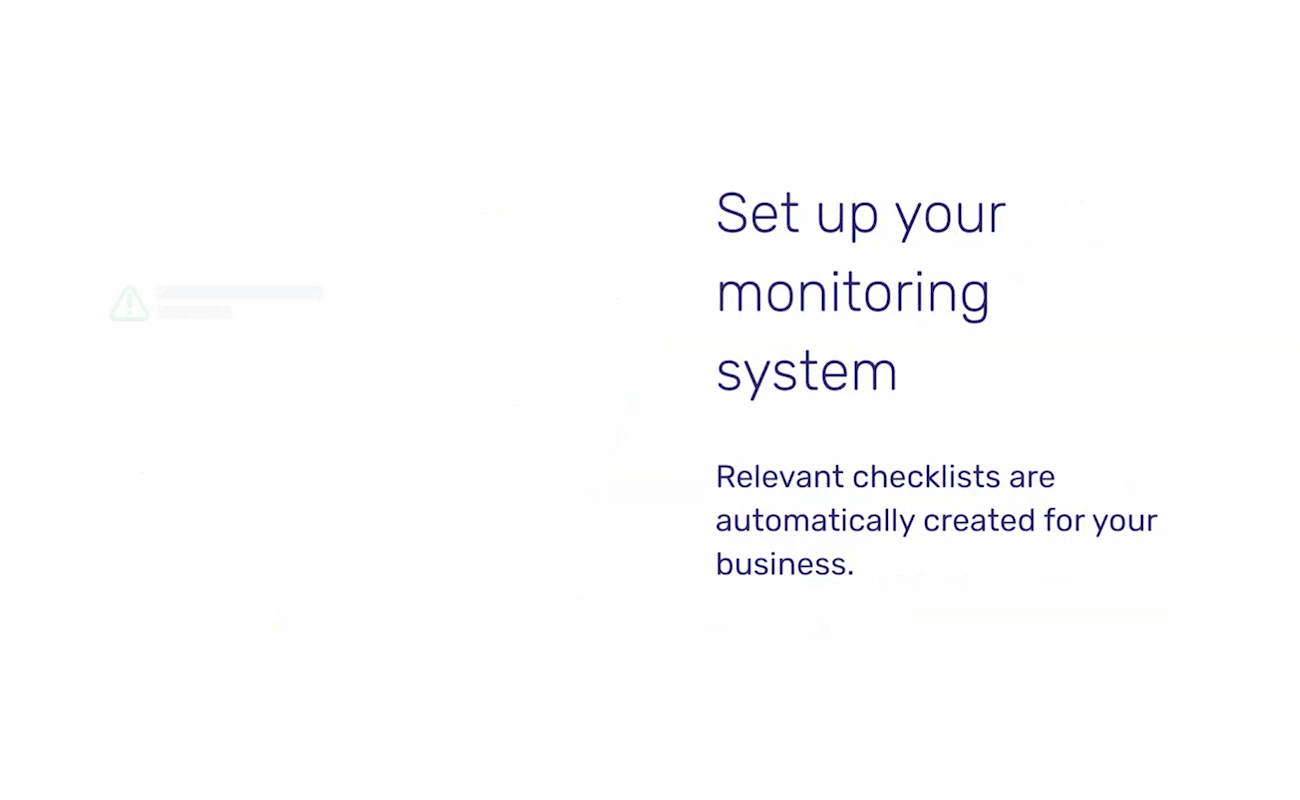Why Is Food Safety Important In Healthcare? Healthcare Leaders Guide
Learn challenges healthcare foodservice teams face today and key food safety practices to protect vulnerable patients. Get a free healthcare leader...
Strands of hair can lead to the growth of unwanted bacteria in food and cause foodborne illnesses.
Hair in food is unappetizing for any consumer, and it can potentially cause foodborne illness. Contamination of food due to hair is a common food safety hazard that can significantly affect customer perception toward your business.
In addition, food establishment operators who are found to be not compliant with food safety hair rules can receive health code violations. As part of your approach to food safety, your team must know who is required to wear a hair restraint while working with food.
Prevent your customer's loss of interest in your business and protect public health from contamination by understanding how you can control hair during food preparation.
WHAT WE'LL COVER:
In the U.S., the FDA Food Code offers food safety guidelines on what hair restraints are acceptable and who is required to wear a restraint while working.
The Food Code requires that food employees wear hair restraints that are designed and worn to effectively keep their hair from contacting exposed food; clean equipment, utensils, and linens; and unwrapped single-service or single-use articles.
The most important reason for having food handlers wear hair restraints is to: prevent physical hazards from contaminating foods, causing foodborne illnesses, and loss of customer satisfaction.
Food safety hair guidelines about hair restraints help prevent cases of hair on food which can lead to contamination and loss of appetite. Food employees are not allowed to touch their hair when working to prevent cross-contamination with food. To help prevent this scenario, restraints are necessary.

The best way to prevent hair contamination in food is to wear protective restraints. Food processors and handlers can use hair nets, kitchen caps, or other acceptable protective gear. Hair restraints are a part of the proper attire for food handlers, especially if they are designated in the kitchen.
Food handlers must first be acquainted with the risks of contamination when they do not wear hair restraints. Training on proper food hygiene must include how to wear proper uniforms, clean clothes, and protective gear as part of food safety practices. The training must also clearly identify what type of food safety hazard a strand of hair is and what it could potentially lead to.
Knowledge of this food safety hazard can help food handlers become more aware of their surroundings and how they present themselves. Include wearing of hair restraints in your everyday food hygiene checklist to help employees remember the task. Use this checklist to ensure that all employees are following hair-related food safety rules before starting their everyday operations.
The hair of food employees can be easily restrained with the proper tools. You can provide food employees with hair nets and caps. Food handlers with long hair can also use headbands in addition to hair nets. Although there are no particular rules on the use of clips, make sure that they are not loose as they can become physical hazards on food.
Food handlers with beards may be required to wear a beard cover, depending on the length of the beard. In addition, food handlers can also use disposable gloves and arm guards for extra protection. Covers and restraints can help minimize the likelihood of food handlers touching their hair in the food service industry.
Food handlers who have direct contact with the food being prepared are required to wear proper hair restraints during working hours. The list of food handlers required to wear hair restraints includes employees in food production positions, kitchen staff, chefs, operators of machines, and other employees who will enter the kitchen.
These food handlers are at the most risk of causing cross-contamination with unpackaged food. Proper food hygiene is key to help prevent touching hair or having strands fall off into the food being prepared.
Employee staff in food production who do not have direct contact at all with unpackaged foods are not required to wear hair restraints. These employees include bar staff, servers, table bussers, grocery checkers, greeters, and clerks. The list of exempted employees from wearing hair restraints generally possesses a very minimal risk of contamination.
In addition, a food handler is not required to wear a hair covering while taking a break.
Despite being exempt from this food safety hair rule, all employees are expected to present themselves accordingly and contribute to minimizing the risk of contamination. Employees with very long hair are encouraged to use a ponytail to pull the hair from their faces.
Food handlers must use a cover or an effective hair restraint to protect the food, preparation surfaces, and clean equipment from contamination. In addition, the food handler's hair must be neatly kept and tied back.
Preparations before working, such as equipping hair restraints, must be done in the locker room, restroom, or any space provided for employee preparation. Fixing the hair must never be done inside the kitchen to minimize the risk of cross-contamination.
All food handlers working inside the kitchen must wear hair restraints. Chefs and sous chefs commonly wear distinctive hats, identifying their position in the kitchen and being a form of hair restraint.
Other kitchen staff, such as aides, dishwashers, and machine operators, are not required to wear a hat. Instead, they can use hair nets, scarves, and beard restraints.

More commonly, chefs wear a white hat rather than a hair net. Chefs spend the most time preparing the food to be served to customers in a food service establishment; therefore, they are required to wear hair nets or hats. Hair restraints can be reinforced with a chef’s cap to help prevent contamination of the dish being prepared.
In case chefs have beards, an additional layer of protection using beard covers can be used. The likelihood of food contamination by hair is highest during food preparation than during service time.
Food handlers with facial hair must ensure that their hair does not get in the food. Facial hair, such as overgrown sideburns, mustaches, and beards, may require protective gear. There is no exact rule nor health code beard length that will require restraining. Different locations may have particular rules on when is the right time to wear facial hair restraints.
As mentioned, there are no particular beard net regulations referring to the required length of beard that will require restraint. In some states in the U.S., local policies require a beard restraint when the facial hair exceeds half an inch.
Because of the phrase “if appropriate” in the FDA Food Code rule relating to the use of beard nets, food handlers find it hard to discern when the protective covering is necessary. The need to wear a beard net will depend on a food establishment's internal policies and local health rules.
Food handlers are advised to avoid touching their face to avoid cross-contamination of potential hazards to food. Foodborne pathogens such as the bacteria Staphylococcus bacteria, a known cause of foodborne illness outbreaks, live on the skin of human beings.
Touching your face and hair during food preparation can transfer the potentially present foodborne pathogen into the food you are handling. In addition, this scenario increases the risk of hair falling into the food. This solidifies the notion that food handlers with facial hair must use protective restraints.
To help prevent the risk of cross - contamination, food handlers must wash their hands after touching their face. Proper handwashing effectively removes any harmful bacteria that may have transferred underneath the food handler’s nails and on their hands. If food handlers wear gloves when they touch their face, they must be changed to ensure the safety and clean condition of the working area.
Hair that is found in food is generally considered a foreign material and, therefore, physical contamination. Although strands of hair cannot cause injury, cuts, or choking, finding hair on food can be off-putting for consumers.
The real damage that hair could cause to consumers is its potential to cause microbiological contamination. Hair, both from humans and pests, can carry biological hazards, such as different types of pathogens. These pathogens can then cause foodborne illnesses to customers.
The best way to prevent food contamination from human hair is to maintain strict and proper hygiene in the food workplace. Proper food hygiene covers several areas of food safety. It includes properly wearing protective equipment, such as hair nets and beard snoods.
Food hygiene also includes personal hygiene matters, such as showering daily, proper handwashing, trimming nails, and leaving work when sick. The objective of maintaining food hygiene is to minimize the risk of causing foodborne illnesses as a result of contamination from food handlers.
In addition, hair restraints must also be regularly changed to prevent the accumulation of hair net bacteria. As part of proper food hygiene, hair nets and caps must be regularly cleaned, and disposable hair nets must be thrown away.

In food service establishments, reactions to finding a strand of hair in food can be stressed immediately. How food handlers react to the customer complaint can affect the satisfaction of the customer.
As a food safety step, the food must be replaced. Food handlers must follow these guidelines to properly address the situation:
After dealing with the situation, all collected information must be communicated with the team and addressed. As a food safety manager, you need to find the source of hair contamination and apply corrective actions. You can issue a violation ticket to the person responsible or conduct food hygiene training for the whole team.
Make sure to have daily reminders and checklists during food establishment inspections by the health department to ensure that food handlers always wear hair restraints. You may use one of our food safety templates at our food safety template hub.
To help you ensure consistent food safety compliance while improving your team's efficiency with less effort, use our digital solutions at FoodDocs. We offer an intuitive solution to help your team remember all the necessary tasks to prevent the occurrence of contaminations.
Achieve consistent food safety compliance when you sign up for our digital Food Safety Management System and get the following benefits:

In addition to features that will help your team remember food safety tasks, our digital Food Safety Management System software can also help managers save time and improve efficiency in managing.

Setting up digital FSMS at FoodDocs
Switching to our digital platform is as easy as answering a few basic questions about your operations. These questions will describe the nature and category of your food business to our system. Using artificial intelligence and a machine-learning program, our system can automatically generate a personalized template for food safety documents and a monitoring system for your team.
Become more sustainable by using our effective digital food safety systems instead of traditional pen-and-paper systems. We have made digitalization really easy for you.
Join more than 30,000 food businesses that are using our system for food safety compliance now with our free 14-day trial.
Do you have more specific questions regarding the topic of food safety hair rules? Check out some of the most frequently asked questions and their appropriate answers here.
No food safety law prohibits food handlers from growing beards. Food handlers can have beards while working around food, provided that they ensure that there will be no contamination due to hair. To prevent this scenario from happening, food handlers with facial hair must wear beard restraints.
Food handlers can wear a ponytail during food service. However, if a food handler is working directly with food, then they will be required to wear hair nets to restrain their hair. Food servers, on the other hand, are not part of this rule as they have very minimal exposure to the food being served.
There is no specific rule that prohibits the use of a hat to use a hair restraint. Despite this, hairnets are preferred. Preferred hair restraints must be designed to effectively contain the employee’s hair and be appropriate for a food workplace. Specialized caps designed for food service are also available for use.
Although dishwashers do not have direct contact with the food being prepared, they are still required to wear hair restraints for food contamination prevention. The dishwashing area is commonly inside a commercial kitchen, where all the food products are prepared. To prevent any stray hair from contaminating the facility, dishwashers, and all kitchen workers must wear approved hair restraints.
As the FDA Food Code implies, food servers are not required to wear hair restraints. Food servers have very minimal exposure to prepared foods and pose a small food safety risk of contamination.
If food servers have very long hair, food safety requirements recommend that they wear minimal restraints such as hair ties, clips, or ponytails.
Learn challenges healthcare foodservice teams face today and key food safety practices to protect vulnerable patients. Get a free healthcare leader...
Learn what Standard Operating Procedures (SOPs) are and how to write effective SOPs that ensure consistency, efficiency, and safety in your...
Boost your retail food safety with essential practices and digital tools to protect customers and your brand. Plus a free Retail Food Safety Leader...